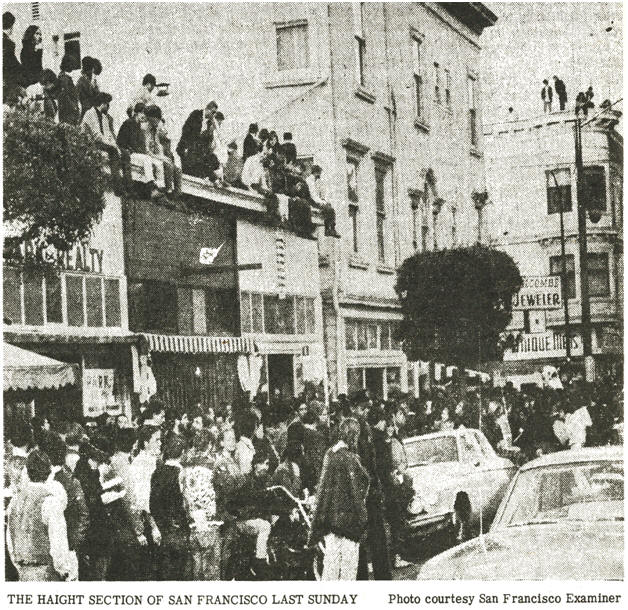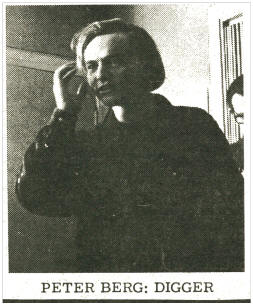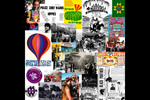Full text articles by and about the Diggers (4)
By Art Kunkin
Los Angeles Free Press
March 31, 1967
[Transcribed by EPNoble, 22 Sept 2011]
San Francisco kaleidoscope: "War on Hippies," (Banner headline, San
Francisco Chronicle); "Freedom Means Everything Free," (From a Digger
leaflet printed by the Communication Company); "If you're not a Digger,
you' re property,” (Communication Company newspaper); "The Government of
the City of San Francisco is hereby declared Null & Void," (Digger
leaflet); "Police Chief Warns Hippies," (Banner headline, Chronicle);
“If you really believe it, do it," (Communication Company newspaper);
“Huge Invasion, Hippies Warn S. F .," (Banner headline, Chronicle);
“There will be no riot this summer, there will be war," (Roy Ballard,
black power leader as quoted in Berkeley Barb).

San Francisco last weekend was a city that seemed on the verge of
revolution. The streets of the Haight-Ashbury section were filled with
hippies, patrolling police cars and bands of tourists, some of them crew
cut types looking for trouble.
Anyone of the right age and costume (young and freaky) or with the
proper introduction could start a conversation with a young person and
within an hour be at a Diggers youth hostel or a private home, provided
with food, a place to sleep, a sexual partner and a variety of drugs
from LSD to crystals (methadrine) or pot.
The ability to become involved in intense discussion and immediate
relationships with total strangers resembles a scene out of the great
French Revolution as described by Michelet or LeFebvre. It Is like Watts
in Los Angeles with the exception that the revolutionary youth of San
Francisco are far better organized with a number of storefront
headquarters, Digger houses and even a group (The Communication Company)
that prides itself on producing topical leaflet newspapers within 30
minutes anytime during the day or night.
The situation is much more intense than on the Sunset Strip. The
hippies don't live on the strip or near Canter's; they come out of the
woodwork from all over L.A. and visit their hangouts like tourists. In
the Haight, however, the hippies live and freak publicly in a walkable
area.
The Haight community has been slowly forming in the last seven years. In
1960 writers and artists began to move from North Beach to the cheaper
rentals of Haight. In 1962 Negroes began to move in from the Fillmore
section, rents dropped and the area of grand old houses became still
more desirable to the creative. However, there was still no visible sign
of the change in the community apart from the new Negro residents and
the establishment of the Blue Unicorn Coffee House.
It was only with the establishment of the LSD generation in 1965 and
1966 that hippies began to freak on the streets in their distinctive
dress and hair styles, psychedelic shops opened and the area took on the
open look of the hippy community. Then came the articles in the
underground syndicate newspapers and the national magazines emphasizing
the power of the local rock music scene, the dances at the Avalon and
Fillmore, the powerful nouveau art posters of Mouse and Wes Wilson, and
the Haight became a magnet for disaffiliated youth from all over the
country.
Everyone in the city is now concerned that the influx of thousands of
hippies during the Easter Week Vacation into San Francisco is a forecast
that this city of 800,000 might be visited this coming summer by as many
as 100,000 indigent and hungry youth. The city government takes this
possibility so seriously that they have hastily enacted regulations
forbidding sleeping in the park and beefed up police patrols. The city
has also announced plans to send teams of health inspectors into the
Haight to close down hippy houses on the grounds of overcrowding, poor
sanitation and the threat of bubonic plague.
Trying to show that the hippy invasion can be handled in a more
loving fashion, the Diggers have set up free youth hostels, free soup
kitchens (at least one such in a travelling VW bus), free clothing
distribution centers and are rumored to have made arrangements with
neighboring farms to house youths and grow food to distribute free in
the city. Digger signs are posted in many Haight stores asking for
donations of hammers, tar paper, wheel barrows, tents, shovels, manure
spreaders and camping equipment.

The original group of Diggers were five ex-San Francisco Mime Troupe
members, including Emmet Grogan and Peter Berg, who got together last
July and issued a Manifesto to the Mime Troupe calling for total theatre
in the streets. Having a concept of theatre which includes anything that
can happen to people in real life, one of the Digger distribution points
is a store at 901 Cole, called "Trip Without a Ticket." The Diggers say
that they "offer the store as a social art form."
The original five adopted the name of Diggers because, during the
17th Century English Revolution, Gerrard Winstanley and William Everard
formed a small group called "The True Levellers," or "The Diggers," with
a primitive socialistic program of sharing the wealth.
A typical San Francisco Diggers' leaflet echoes Winstanley: "Well,
the time has come to share. Diggers are people who share … so be a
Digger. There will be more and more and more and you will be more and
more and more. The Diggers take part in the Invisible Government. God is
on your side. Take part in the Invisible Government. Share food in the
park every day at four. That's the Panhandle Park at the corner of Oak
and Ashbury. Are you deeply religious? Share. Are you for peace? Share.
Are you for freedom? Share. Are you overstuffed? Share. Are you just out
for kicks? Share. Be responsible. Take part in the Invisible
Government.”
The Diggers are, in fact, the invisible government of the Haight, and
set the tone for the whole community. They have grown to be an amorphous
organization with no leaders, members, committees, dues or any trapping
for formal organization. The result is that many people who share the
Diggers' hospitality without a full conception of Digger ideology
identify themselves as Diggers but will fend off any inquiries, saying,
"Go see Grogan."
The Diggers received a lot of publicity recently as a result of a
meeting held with the Haight Independent Proprietors (HIP), an
association of the psychedelic shops and boutiques on Haight Street. At
this meeting Grogan challenged the right of HIP to be the spokesman for
the local community, charging that the merchants are only engaged in the
business of making money. Published reports of this meeting say that the
Diggers threatened to bomb or steal the merchants out of business unless
the merchants reorganized themselves as nonprofit ventures, plowing
surpluses beyond a reasonable salary back to the community. Persons
close to the Diggers deny these reports, saying that the Diggers offered
the non-profit conception only as a suggestion and that the Diggers made
no threats beyond "blowing the merchants' scene through publicity"
unless the personal profit making stopped.
While the police privately express relief that the hippy community of
the Haight is "nonaggressive," there are persistent rumors in San
Francisco that some individual Diggers are secretly arming themselves in
preparation for clashes with the police. This writer spoke to persons
around the Communication Company, who are closely allied with the
Diggers, and these persons did not deny this rumor. There was a specific
recognition that the Digger hostels are full of unemployed, angry young
men who are not committed to a flower children's philosophy of
non-violence.
So, on the one hand, there are the leaflets which say: "This is the
Diggers' thing: no money, everything free. The Diggers are practicing
the Cardinal Virtues because that's the thing to do." On the other hand,
if the Diggers are right, there will be thousands of hungry and angry
young people in San Francisco this summer and it will take a lot of
action and education by the Invisible Government to prevent the
development of demagogic and totalitarian leaders.

One of the most interesting and important organizations that has
developed in the Haight is the already- mentioned Communication Company.
The Company is a commune (there are many communes in the Haight),
consisting of six people. Chester Anderson, a novelist and former
publisher in 1959-60 of the literary beat generation magazine, "Underhound,"
is the recognized inspirer of the Company. Other members of the commune
are Claude Hayward of the Ramparts staff, and his wife, Helene; Dawson,
the former manager of the Venice West Coffee House in Los Angeles (who
coordinates distribution of leaflets); a man who operates the printing
equipment and a kitchen man.
Living in an upstairs apartment south of the Haight, the Communication
Company in mid-January put $300 down on a Gestetner printing press and a
Gestefax electronic stencil cutting machine. These simple office-type
machines can be operated by anyone with a small amount of training and
permit the Communication Company to miraculously produce in as little as
ten minutes hundreds of copies of multicolored leaflets containing
photographs, typewritten or handwritten material - which are all over
the Haight within the hour.
Beginning with a leaflet put out at the San Francisco Be-In, the
group estimates that they have put out over 500 leaflets in a total of
more than half a million copies. Just last week the operation produced
30,000 copies of various leaflets.
The policy statement of the Company states that they are providing an
inexpensive printing service to the hip community (free to the Diggers,
at cost or with a small service charge to maintain the Company for
everyone else). Issuing instantaneous leaflet newspapers which are
widely read and distributed in San Francisco, and even Berkeley, the
Company claims the right to be "outrageous pamphleteers who compete with
the Establishment press for public opinion, to produce occasional
incredibilities out of an unnatural fondness for either outrage or
profit, to do what we damn well please, to supplement the Oracle with a
more or less daily paper."
Commercial jobs put out by the Company have included broadsides for the
Mime Troupe, the Committee Theater, the League for Sexual Freedom,
Artists Liberation Front, the Resurgent Youth Movement, various
boutiques, light shows, dances, parties, and letters issued by
individuals to the hippy community including criticisms of Ramparts
magazine and racism among hippies.
Non-commercial jobs include the Digger leaflets, Rules of the Game
for when you're busted, photostatic reprints from the Chronicle, the
L.A. Free Press and the Berkeley Barb (the Communication Company is a
member of the Underground Press Syndicate), Ron Cobb cartoons, posters,
poetry, songs with music, and warning of impending police action. (The
Company claims credit for averting a big marijuana raid on the hippy
community in February).
The Communication Company would, at first, print anything that was
given to them but have learned to establish restrictions after they
printed a leaflet identifying a certain person as “the heat." Within an
hour another group came along denying this and the Company printed an
immediate retraction. As it happens, and this shows the fast tempo in
the Haight, the next day the original informants were arrested for
marijuana possession, leading the Company to believe that there was an
act of vengeance by actual police informers.
When I visited the Communication Company at midnight last Sunday, a
group of hippies were sitting on the floor playing a board game Claude
Hayward invented, called "The Golden Age.” On a huge, hand-painted
wooden map of the world, half the size of the room, the players were
throwing dice to determine the movement of populations. The game is won
by exploiting countries through these population movements. Soon after I
arrived, the high politics were temporarily adjourned to produce still
another leaflet. It was a scene that could only be duplicated in a
command post of a hippy revolution.
[end]
|
|

